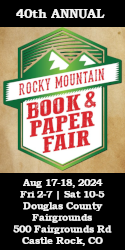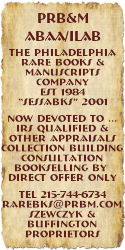Stumbling on Steiner
NOTES FROM THE ANTIPODES
You know what a Waldorf Salad is. Yes, you do. It’s that old-fashioned crunchy salad with bits of chopped-up apple and celery and walnuts, all nicely lubricated with mayonnaise. Now you remember! Even if privately you prefer something with a bit more guts, like a Caesar Salad, with bacon and anchovies. But let me not digress. You probably also know what a Waldorf School is—unless you are English or Australian, in which case “Waldorf Schools” will be more familiar to you as “Steiner Schools.”
What is the link between Waldorf Salad and Waldorf Schools? you ask yourselves. Exactly the sort of footling question which delights and intrigues me too. No wonder the readership of BSM is widely considered to be the most intellectually curious—and the most heartwarming—in the whole world of bibliophilic journalism! And if by some mischance the question fails to delight and intrigue you, be assured that by the time I have done, we will have advanced into the rewarding and rarefied realm of spiritual activity called “Anthroposophy.” (I suggest you practice saying this word a few times out loud now. Get the stress on the middle “o” which is where it belongs, otherwise you will keep stumbling over it later). The delinquent French writer Louis-Ferdinand Celine, in his “Journey to the End of Night” wrote: “Everything that is interesting in life happens in the shadows.” I will be showing you that the converse is true, that on the contrary everything that is interesting in life happens in a blaze, or in a glow, of light. (If it’s sordid you’re after, by all means seek it in the shadows. But keep it to yourself).
To return to our Waldorfs. The Waldorf Salad as you well know is named for the Waldorf Hotel where it was first created. The Waldorf was built in New York in 1893 by William Waldorf Astor. It was later married to the adjoining Astoria Hotel, built by William’s cousin John Jacob IV, to form the Waldorf=Astoria Hotel (pedants will delight in the correct use of the fancy double hyphen). Why Waldorf? A simple mis-spelling of Walldorf, the village in southern Germany where on July 17 1763 Johann Jakob Astor, the founder of the Astor dynasty and fortune in the United States, was born. In 1905, in Stuttgart, Germany Emil Molt, the director of a cigarette manufacturing company bought the trademark rights of “The Waldorf Astoria Cigar Store Company” which at one time had been connected with the Waldorf=Astoria Hotel. Emil Molt was a particularly enlightened employer. In 1919, after hearing Rudolf Steiner lecture on education, Molt engaged Steiner to start a school for the children of the workers in his cigarette factory, using the new ideas and techniques for children’s education which Steiner had been developing. Thus the first Waldorf School was born.
Waldorf, or Steiner, Schools have since spread throughout the world. They are mostly to be found in Northern Europe: in the English-speaking world there are around 170 in the United States, 40 in the United Kingdom, 30 in Canada and as many as 100 in Australia. I have never been inside a Waldorf or a Steiner School but I know a little about Waldorf education. Children are encouraged to learn by play and by discovery, to develop their imagination and their creative, musical and artistic skills. They do not begin to learn to read, or do formal mathematics before the age of seven. There is much emphasis on story-telling, on fairy tales, myths and legends which lead children into the realms of wonder and imagination. The classroom environment is carefully designed: natural fabrics and materials are always preferred to the man-made and the synthetic; colors and décor are planned to promote harmony and calm. Watching television and using computers is discouraged, at least until adolescence, while active play and a form of movement called eurythmy (more about this later) are strongly promoted. In short, at the primary level, children are encouraged—and allowed—to be children.
Considering Steiner’s influence in so many fields, and his literary output, it is remarkable how little, in English-speaking countries at least, most people know about him. It is not my purpose here to chronicle his life in detail but the bare outlines are these. Rudolf Steiner was born in 1861 in Kraljevec (now in Croatia) of Austrian parents. At school and at college in Vienna he studied mathematics and the sciences, whilst also immersing himself in the classics, literature and the arts. He developed a strong interest in philosophy, particularly in the German philosophers Kant, Fichte, Hegel and Nietzsche and he gained a Ph.D. for a dissertation published later as Truth and Science. At the age of 23 he was asked to edit an edition of Goethe’s scientific works and he later worked at the Goethe archives in Weimar. Steiner felt a special affinity with Goethe, sharing with him a spiritual view of the world; he became a respected authority on many aspects of Goethe’s life and work. For years Steiner made his living, mainly in Germany, as editor, private tutor, reviewer, lecturer and writer. In 1894 he wrote a key book: The Philosophy of Freedom which encapsulates much of his anthroposophical thinking.
In 1901 Steiner joined the Theosophical Society and lectured widely and energetically on theosophical themes. In this period he wrote some of his most important books: Christianity as Mystical Fact (1902), Theosophy (1904), Knowledge of the Higher Worlds. How is it Achieved? (1904) and Occult Science—An Outline (1910). He came into contact with the leading Theosophists of the day, notably Colonel Olcott, Madame Blavatsky, Annie Besant and Charles W. Leadbeater but broke away from Theosophy when it seemed to him to be too much influenced by Eastern—particularly Indian—religion. The final straw seems to have been Leadbeater’s proclamation of the young Jiddu Krishnamurti as the future leader of the world, the bearer of the Maitreya Buddha and “the re-appearing Christ.” Thereafter Steiner worked tirelessly to make public his teachings on Anthroposophy, through lectures and books. He applied his anthroposophical principles in a wide range of fields: education, medicine, art, architecture, agriculture, economics, drama, music, poetry. His energy was prodigious. It is said that the German edition of his collected works runs to 350 volumes. Many of these books are transcripts of his lectures, of which he delivered as many as 300 in a single year in different cities of Europe. He died in 1925, in Dornach, Switzerland where he designed and built the Goetheanum, a remarkable structure which was and still is the headquarters of The Anthroposophical Society.
Such are the bare bones of Steiner’s remarkable life, his exoteric life at least. Some large claims have been made on his behalf, for example this one, taken from the introduction to Rudolf Steiner: An Introduction to his Spiritual World View (Temple Lodge 2001) by Roy Wilkinson: “From 1861 to 1925 there lived another personality whose accomplishments were even greater than those of Leonardo or Goethe and in whose mind dwelt apparently unbounded earthly and cosmic wisdom. This was Rudolf Steiner.” Greater than Leonardo or Goethe? How embarrassed Steiner would have been by such an accolade. On the other hand, Steiner has never lacked detractors, including (are you surprised?) George Bernard Shaw. Shaw’s friend Arnold Freeman reports: “I once sent Bernard Shaw a loaf made out of flour grown on Rudolf Steiner’s Anthroposophical principles. Shaw wrote to me : ‘At last, something worth while from a Steinerian.’ ”
Perhaps you squirm—or shudder—when you read words such as “occult”, “mystical”, “esoteric” “cosmic wisdom” “spirituality”, or even “God”. Well, it is impossible to talk seriously about Steiner’s life—his inner life—without reference to such terms. And it is precisely Steiner’s inner life, and his revelations about it and the hidden spirit world to which it relates, which lift Steiner out of the ranks of ordinary human beings. From an early age, Steiner was aware of what he called the “supersensible” world which was just as real to him as the physical world, and just as full of objects and beings as the physical world. This supersensible world was hidden from other people: it was the “occult” world (“occult” in its simple root meaning of “hidden”) and for Steiner it was more real than the “real” world, the world of the senses. Though by nature sociable, gregarious even, Steiner’s ability to see and inhabit his invisible world, left him feeling isolated from his fellows. He made it his life’s work to make the supersensible world known and accessible to others, to share with anyone who cared to listen his esoteric knowledge of the invisible world, and the ancient wisdom of spiritual initiates who preceded him. He called this body of knowledge, and the demands it makes on human beings, “Anthroposophy” (human wisdom) —a complementary force to “Theosophy” (divine wisdom).
Anthroposophy is neither a philosophy nor a religion, as we usually understand those terms. It is rather—to use a useful German word for which there is no exact English equivalent—a Weltanschauung—a world view or a view of the world. Steiner himself defined Anthroposophy as “the consciousness of one’s humanity”; it is also defined as “a body of knowledge concerning the spiritual in man and in the universe” or simply as “a path of knowledge” or as “spiritual science”. However we define it, Anthroposophy implies a quest by the individual for self-knowledge, for spiritual development, and a desire to penetrate the mysteries of the non-material world. An individual on the path seeks the truth through spiritual activity: meditation, concentration, thought, mental effort. In this, and in its teachings on reincarnation and karma, Anthroposophy clearly has something in common with other spiritual paths such as Buddhism. But at the heart of Anthroposophy stands the mystery of the Christ, God incarnate. In every human being, says Steiner, there exists incarnated a spark of the divine light, of the Supreme Being, of God. The mission of the individual on the path is, by spiritual activity, to nurture this spark until, as a great light, it illumines the whole of one’s existence and finally brings one to one-ness with God.
Well, there it is. I have used the three-letter G-word which offends so many people. It clearly offends Richard Dawkins who in his recent book The God Delusion (Houghton Mifflin, 2006) refutes the existence of God with all the passion of the zealot. Why protest so much, Richard? I was heartened to hear Professor Graeme Clark, medical scientist and inventor of the Cochlear Implant (the “bionic ear” for the deaf) say this on radio the other day as he delivered the first of his Boyer Lectures : “It would be necessary for someone to know everything in the world before he could categorically assert that God did not exist.” How refreshing! There are many things in the world—and beyond this world—that science simply cannot explain. Not yet, and perhaps not ever. And I can’t help feeling—as I grow older and mellower—that God, or a Supreme Being—does exist: which explains a lot of things about life (and death) that science cannot. I asked an Anthroposophist friend if she believed in God: “I don’t believe in God,” she said. “I know God.” It is the same answer that Carl Gustav Jung gave to this question, put to him towards the end of his life.
I became a paid-up member of The Anthroposophical Society of Australia about three months ago. There was no drama, no oath of allegiance no initiation rites. Just a cheque to put in the mail. If I have joined a cult it’s a very low key affair. But it is clearly not a cult. Anthroposophist are not a recruiting or prosetelyzing lot. Steiner reported what he knew to be the truth: it was up to others, he said, to choose to accept it or not. In order to become an Anthroposophist, there are certainly no ideological hurdles to clear, no acts of faith to perform, no articles of faith to recite: all that is required is a general sympathy with Steiner’s teachings. You can come (and go) as you please.
It is hard for me not to be sympathetic with much of what Steiner stood for. He was remarkably modern in his thinking. For example, early in the twentieth century, when artificial fertilisers and chemical pesticides were being developed and long before words like “Green” and “ecology” and “sustainable” were invented, Steiner was advocating a return to traditional organic farming, using the rhythms of the moon as a guide to planting and harvesting. His system of agriculture is now well known as “biodynamic farming” and organic farm produce which is grown on anthroposophical principles carries the “Demeter” label or imprimatur. Try some for yourself and see (as Bernard Shaw did) how good it is! And beware of genetically modified crops, which, I can’t help feeling, will never, and should never, receive the “Demeter” endorsement.
It was by way of biodynamic farming that, early this year, I first stumbled over Steiner. I attended a field day on a property near where I live and listened to various speakers extol the wonders of biodynamics and particularly the elixir called “500” which is what you spray on your fields to make them fertile and happy. At the temporary bookstall in the tractor shed, run by “Biodynamic Agriculture Australia,” I scooped up a number of books written by Rudolf Steiner, both on agriculture and other subjects. Shortly afterwards, I met someone in my shop who turned out to be the director of “Aurora Australia”, an Anthroposophical College of the Arts here in Melbourne. We got to talking about Steiner, and before long I was enrolled in a Steiner study group, a painting class and a eurythmy class.
Eurythmy is a performance art form invented by Steiner and his wife Marie in 1912. Eurythmy looks, at first sight, much like a form of dance but it is more accurately defined as “speech and music and colors made visible in movement”. Eurythmists seek to bring the divine inspiration from the spirit world into their performances. “Eurythmists want to make the soul sing,” says my teacher. “By listening to the vibrations, the harmony created by music, the eurythmist perceives patterns, colors and forms which are then translated into movement.” Even novices like me, who stumble around with two left feet, occasionally glimpse this divine provenance. It is the same with music. The anthroposophist musician, whether as composer or performer, looks to link his/her spirituality with that of the spirit world, to draw music from “the music of the spheres” and beyond. Contemporay Estonian composer Arvo Part is an anthroposophist whose music seems to me to come directly from heaven and to transport the listener back to the highest realms of the spirit. If you despair of modern orchestral or choral music and you do not know the work of Arvo Part, seek him out and be delighted.
My painting class has been the real revelation. For one who was told at an early age
that he was “not much good at painting” it has been a delight to approach the easel with an
open mind, an open heart even. Art for anthroposophists is not about representational or life
drawing; it involves reaching into the spirit realm and bringing down the inspiration you
find there, transforming it with your imagination. “All art is the mirror of the spiritual world
in the world of the senses.” “Blue is the lustre of the soul.” Such pronouncements set a man
thinking. And I find, that after all I can paint, in my fashion.
I am also attracted by the notion of “soul architecture” which is the subject of a book Places of the Soul by Christopher Day (Thorsons 1999). Day is an English architect who designs buildings largely on Steiner principles. He emphasises things that you would think should be self-evident but which (apparently) to many builders and architects are not: the importance of scale, texture, harmony, respect for the site, respect for the inhabitants, use of the right materials, insulation and natural light. Buildings do have souls—most of us can feel the tormented soul of a sick building as well as the calm and harmony of a healthy one. Good building does not happen by accident. Steiner’s influence on architecture is seen mostly in the design of Waldorf/Steiner schools. But thanks to people like Christopher Day it is spreading to domestic and even to civic architecture.
The sub-title of Christopher Day’s book is: Architecture and Environmental Design as a Healing Art. Healing was one of Steiner’s particular missions. He advocated therapeutic methods which are still widely practised today, in curative eurythmy and anthroposophical medicine. Some of his methods, I believe, revive ancient herbal remedies, others incorporate wholistic and homoeopathic techniques. For followers of Steiner’s medical teaching there is always a close connection between the “healing” and the “holy”—a nexus even more clearly seen in the German words “heilen” (to heal) and “heilig” (holy). And no human being can be truly whole and healthy without a healthy soul.
The best film I’ve seen all year was Die Grosse Stille (“Into Great Silence”) directed by Philip Groning. It’s a documentary about life in a Carthusian monastery, La Grande Chartreuse, founded by St. Bruno in 1084 in the mountains above Grenoble, France. Carthusian monks make the usual monastic vows of poverty, chastity and obedience: they also make a vow of silence. So they live their lives in an atmosphere of contemplation, calm and peacefulness. How can a two-hour film without dialogue and largely without music (apart from a little Gregorian chanting), which features no sex, no guns, no car chases and no violence, make such compelling viewing? Partly, no doubt, it is the excellence of the film-making but mostly I suspect it is the subject matter which intrigues and satisfies. We who live in the busy bustling world of getting and spending have, many of us, a deep yearning for an alternative way of life, at the core of which is stillness, calm, silence, rest; all the things encapsulated in the German word “die Ruhe”.
Rudolf Steiner thought that this sort of monastic life was no longer a solution. Like Milton he was unable “to praise a fugitive and a cloistered virtue.” Modern men and women must engage with life, not withdraw from it. In our cluttered daily lives we must simply find the time and space for stillness. And, guided by the light on the path, our search for self-knowledge and fulfillment must not be for our own benefit but rather for the benefit of others, for the rest of humanity. Steiner was entirely optimistic about humankind: that eventually the world would evolve into a place entirely peopled by loving peaceful beings with beautiful healthy souls. It is hard not to love a man with such a large and generous Weltanschauung.
It is not difficult to find Steiner’s books in English: they are widely distributed and available, though more likely to be found in specialist esoteric bookshops rather than in general bookstores. Here in Melbourne they are easily located at the Theosophical Society Book Room and in the charmingly named Steiner bookstore “Books for The Journey” (a name which has confused—and disappointed—many a prospective buyer of “Lonely Planets” Frommers” and “Rough Guides”!) It is much less easy to find secondhand copies of Steiner’s books in used bookshops. I doubt whether in 30 years of bookdealing more than a dozen or so have passed through my hands. I suspect that they are tightly held by anthroposophists. In any case, Steiner’s books are not easy: they demand concentration and attentiveness. The path which Steiner indicates is not for the faint-hearted: the spiritual journey requires energy and effort.
It may be that, having read thus far, you have not the slightest intention of reading anything by Steiner anyway. It may be that, from what I have written about him, you consider him to be a crank or a crackpot. And me too, perhaps. Well, that is your perfect right. But you may like to ponder something Isaac Newton said, when fellow scientists chided him for spending the last thirty years of his life studying astrology. Why, they wanted to know, would a great scientist like him, with all his intellectual prowess, his scientific knowledge and his academic rigor, waste his final years studying a crackpot pseudo-science like astrology? Newton thought for a moment then answered quietly: “Gentlemen, I have studied astrology. You have not.” Do not be too hasty to pass judgment on Rudolf Steiner.
Hamlet said: “There are more things in heaven and earth, Horatio, than are dreamt of in your philosophy.” Steiner was one man who was able to see and articulate those undreamed of things.
Anthony Marshall is owner of Alice’s Bookshop in North Carlton, an inner-city suburb of Melbourne, Australia. He is a member of the Australian and New Zealand Association of Antiquarian Booksellers and author of “Fossicking for Old Books” (Melbourne, 2004).

























